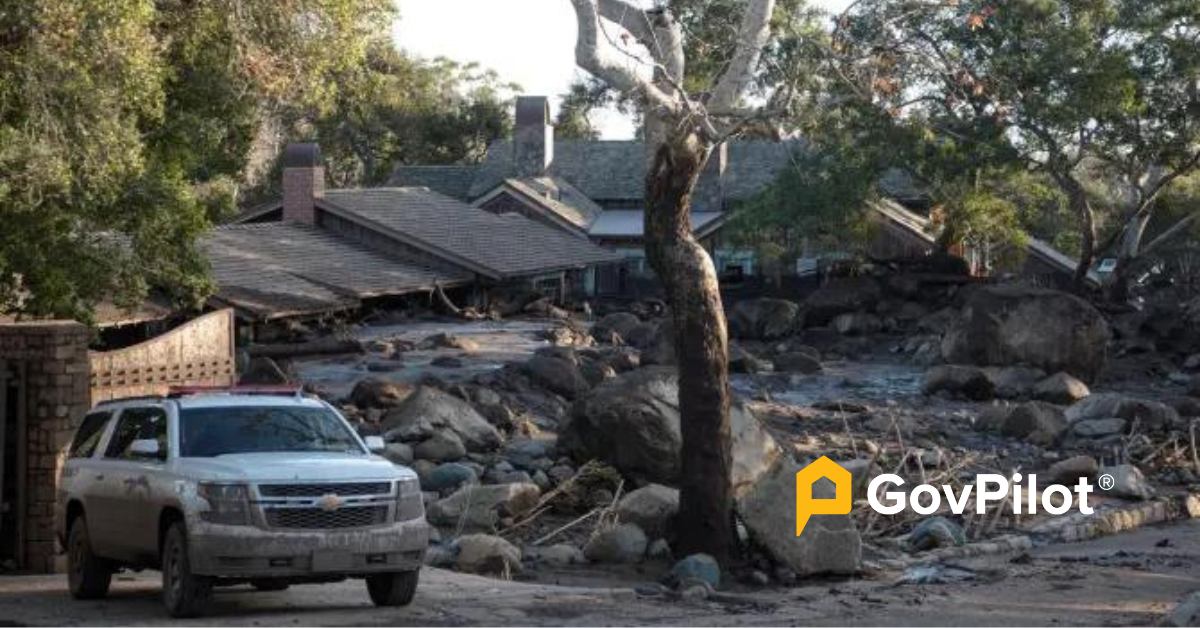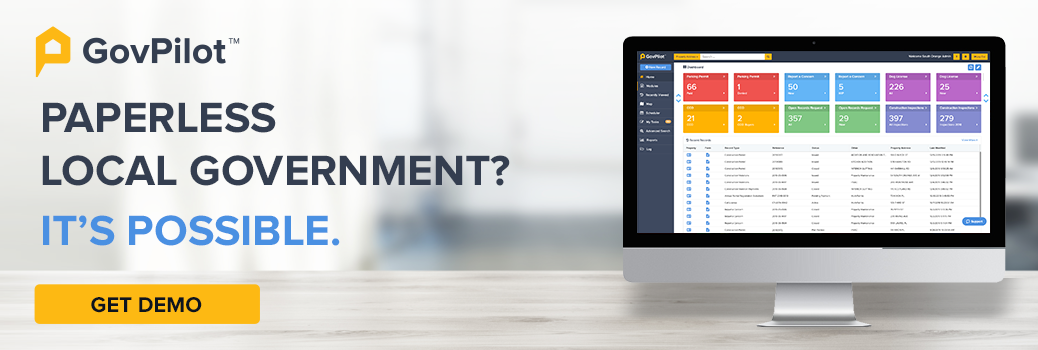Picture this. You’re exploring Yellowstone, one of the most popular national parks in the country. You finish a wonderful hike and get back on the road completely exhausted. As you drive towards the exit of the park, massive rocks begin rolling off the mountainous terrain and into the road. You hit your brakes and avoid feeling nature’s wrath by a few meters.
As scary as this might sound, in June 2022, heavy rain led to mudslides that destroyed entire bridges and roads in Yellowstone. Driving along any highway in Utah, Arizona, California, North Carolina, upstate NY, or any mountainous state, you’ll notice signs saying beware of rockfall or mudslides. But these disasters which often occur after heavy rainfalls are not limited to remote areas, increasingly they are occurring in developed areas. In 2018, a devastating mudslide in Montecito, California killed 17, trapped 300, and damaged hundreds of homes including Oprah Winfrey’s.
If you community is located in an at risk area, you owe it to your constituents to take precautions against landslides, and to educate community members on the right protocol for mitigating and responding to a landslide disaster. Follow along for everything you need to know.
What is Landslide Mitigation?
Landslide mitigation is taking precautionary actions to prevent rock or mudslides from imposing damage on physical infrastructure in your community and endangering community members. To mitigate landslides, your local government should take action to install protective structures like retaining walls, designing debris pathways, setting up proper drainage, and educating constituents on preventative and responsive protocols related to landslides.
Why is Landslide Mitigation Important for Your Local Government?
25-50 Americans die every year as a result of a landslide. Thousands of others are directly impacted as a result of local infrastructure like roads, bridges, or tunnels becoming impassable or outright destroyed. Landslides can cause severe damage to homes and businesses situated on or near hillsides.
Here are some of the key reasons your local government needs a landslide mitigation strategy:
1. Destruction of local physical infrastructure
A large landslide can leave entire communities completely ravaged in its wake. Bill Brown, the Santa Barbara County Sheriff, explained, “The only words I can really think of to describe what it looked like was [that] it looked like a World War I battlefield. It was literally a carpet of mud and debris everywhere,” in the wake of a horrific landslide that destroyed homes and killed or injured 40+ people.
Without proper mitigation techniques, physical infrastructure in your neighborhood could be turned to rubble.
How To Mitigate the Impact of Infrastructure Damage from a Landslide in Your Neighborhood?
Landslide mitigation is essential to preventing serious damage to your physical infrastructure and constituents. Here are a few high-level landslide mitigation strategies for keeping your neighborhood intact:
- Understand the land in your area: your local government will need to assess and document the areas in your community that are most at risk to experience rockslides or mudslides. These are especially important to consider when building new properties or planning landslide evacuation routes for your local government. Local GIS mapping technology makes it easy for government officials to make note of areas that pose the largest risk via a 3D map that can be updated in real time.
- Pay key attention to storm water drainage: flooding mitigation is landslide mitigation, as intense rainfall can often cause landslides. Continually monitoring water drainage in your neighborhood and considering opportunities to make improvements will be critical in preventing flood and landslide damage. Mark flood zones in your GIS map too!
- Use chemicals on the slopes: chemical treatment on mountainous terrain can solidify slope materials, preventing debris from slipping and causing destruction.
- Build mitigation structures: launching disaster resilient infrastructure projects to mitigate landslides is an essential precaution you should consider in at-risk areas in your community. Building debris pathways to divert water, retaining walls, fissures, and grouting rock joints will keep local buildings safe.
- Have communication channels in place across the board: if a landslide occurs in your neighborhood, you have lives to get out of at-risk areas. Consider your local government communication strategy and align on the following:
- How will you communicate with community members & local businesses? The easiest means to communicate with constituents is via social media and your government website. Additionally, you should mark major landslide risk areas in your local GIS map. Let constituents know ahead of time that they can check the GIS map to get educated on where debris is likeliest to fall. When a landslide is occurring, they can also check the map for real-time updates made by government officials.
- How will local government officials communicate with one another? Government software allows for remote communication during an emergency. Municipal or county officials can message one another from a laptop or cell phone, meaning critical post-landslide communications can happen (like contact to / from first responders) remotely with ease. If you’re still using predominantly in-person channels for communicating in day-to-day government workflows, be sure to take the time to iron out a gameplan for what to do when a natural disaster occurs.
- How will your local government communicate with FEMA and other federal organizations? The federal government should be contacted as soon as an emergency occurs to help in the immediate aftermath and get you on track to receiving grant funds to rebuild. Local government leadership should build contacts in relevant federal agencies and have protocol in place for contacting FEMA when a landslide occurs.
2. Loss of government data
If you’re still using physical servers and paper files to run governmental systems and store government data, a landslide can erase your digital infrastructure if physical buildings storing your servers are impacted. Using paper-based workflows and/or failing to backup data in the cloud increases the risk of losing your data as a result of any natural disaster. Mud and rockslides are no exception.
Learn more about the pros and cons of still using physical servers for government computer systems in the Cloud vs. In-House Servers for Local Governments guide.
How to Mitigate Against Landslides to Protect Your Digital Infrastructure?
The answer is simple: embrace cloud-based government software! Paper documents are moved into a cyber secure digital format that relevant employees can access with ease and will be backed up regularly, meaning even if a rockslide destroys a municipal building along with its computer systems and paper files, your data will be recovered.
Learn more about going digital as a local government in these helpful guides:
- Local Government Digital Transformation
- How to Go Paperless in Local Government
- Physical Servers vs. the Cloud: Which is Best for Storing Government Data?
What Areas Need to Prioritize Landslide Preparedness Most?
Landslides can and have occurred in all 50 states. That means your local government should absolutely consider landslides, mudslides, and rockslides as a crucial aspect of your local disaster preparedness plan regardless of your location. That being said, the United States Geological Survey (USGS) poses that states like Washington, Oregon, California, Hawaii, Alaska, and others along the Rocky Mountains, Pacific Coastal Ranges, and Appalachian mountains face “severe landslide problems.”
If you can see mountainous views from anywhere in your neighborhood, you need to have a mitigation strategy in place before a slide occurs, and a response team and plan coordinated to respond in the wake of a landslide.
How to Educate Constituents About Landslide Preparedness?
A key part of a landslide mitigation strategy is to prepare constituents of all ages on the protocol for preventing and responding to landslide disasters.
Your local government should use its Community Emergency Response Team (CERT) to host training sessions for constituents about the protocols to take to protect their property from landslide damage, how to communicate with local officials during and after a landslide emergency, and which evacuation routes to use to avoid sliding debris.
In-person training should be hosted for constituents of all ages at locations like public libraries, schools, and retirement homes. You can also offer live virtual meetings via your government website and make recordings of past sections available online too. Educational resources about landslide mitigation should also be included on your website.
Here’s an example Landslide Emergency Management resource from a government entity and the FEMA Landslide Information Sheet for more details on educating constituents.
Don’t have a CERT yet? Here’s a guide on How to Form a Community Emergency Response Team
Considering Landslide Emergency Preparedness
You owe it to your community to be fully prepared for falling debris as a result of a landslide. Rocks or mud pose a risk to destroy infrastructure and take lives if not taken seriously. Your local government should mitigate landslide damage by educating constituents, assessing flood zones and groundwater, using chemicals to treat mountainous terrain, and building protective fissures, retaining walls, etc.. In response to a landslide, your local government will need to evacuate constituents, send out first responders, and work with FEMA to assess the situation and prioritize which infrastructure you’ll need Federal funds for.
Government software is meant to streamline communications and back-up critical government data. To learn more about how GovPilot can improve your government’s natural disaster workflows and processes, book a free demo.
Landslide Preparedness FAQs
What is Landslide Mitigation?
Landslide mitigation is preparation for destructive debris like mud or rocks falling from a sloped surface in your physical area. Local infrastructure should be built to manage water drainage and flood zones (as water can cause debris to fall) and prevent debris from reaching physical infrastructure in your neighborhood. Storage of your important data should be backed-up via the cloud to guarantee it’s protected in the case of a natural disaster.
How to Respond to a Landslide?
Community members should evacuate the area immediately in the wake of a landslide. First responders should assess and report on the scene as soon as possible and federal officials should be contacted and provided with local government data on the situation to send in additional support and grants for rebuilding.
Read on:
- How Local Governments Can Encourage Civic Engagement
- Best Court Management Software: What to Look For
Sources:
- https://www.britannica.com/science/landslide/Landslide-mitigation-and-prevention
- https://www.nbcnews.com/storyline/deadly-mudslide/which-states-are-prone-landslides-how-can-you-prepare-n60761
https://www.habitat.org/our-work/disaster-response/disaster-preparedness-homeowners/landslides










